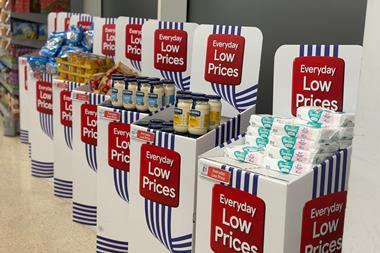Tesco says it has been delighted by ongoing success with CR
as fresh produce joined the fray last year
says Sarah Hardcastle
T esco has fully implemented the second phase of its continuous replenishment programme, a ground-breaking distribution system for food and drink that puts the multiple at the leading edge of worldwide grocery supply chain developments.
Supply chain development director Graham Booth is delighted with the system's progress and results achieved in 2001, the second year of implementation. "Continuous replenishment has taken us four years to develop. Dry grocery was the first to go on in 2000 and last year we put on fresh produce.
"We expected fresh produce to be more challenging and difficult than dry grocery because of the short life code levels involved. But in practice we found that as we rolled it out to groups of stores, the results were so positive and the stores so enthusiastic, we decided to take a small risk and speed up the programme, completing implementation pre-Christmas ahead of our original schedule."
With targets exceeded, Tesco now has all categories of food and drink on the continuous replenishment (CR) system. "The only exception is product that goes to stores direct from the manufacturers, which is about 1.5% of volume," says Booth.
CR is a customer-focused and demand-driven system in which the guiding principle is the achievement of high levels of on-shelf availability. It is a fundamental step change from current sales based ordering systems which batch-process store sales data nightly for next day ordering, delivering up to 24/48 hours later, and which consequently are less responsive to changes in demand.
Central to CR is a highly reactive IT system which is capable of taking any number of sales readings from all stores at any time during trading hours Tesco does it twice daily and which can then be used immediately by the buying teams to increase or decrease orders according to demand. Ordering is centrally controlled, though stores have a limited ability to respond to local conditions.
It is supported by twice-daily deliveries, the second delivery carrying adjusted orders based on the morning's sales readings.
"If, for example, we order 100 cases of lettuces but find in the morning that sales have changed significantly from our forecasts, we can adjust the quantity accordingly for the second delivery.
"We can also adjust quantitites between stores in the same locality, which we do a lot. It's a very flexible and responsive system that reduces stock holding and wastage as well as improving availability. It really comes into its own in peak and busy trading periods," says Booth.
In fresh produce it has brought the additional benefit of reducing field-to-shelf times by between 12 to 24 hours, depending on suppliers' geographical location. "It means we're getting even fresher produce on to shelves," says Booth, "a benefit we're passing on to customers by giving them up to an extra day on shelf life. Our drive is to increase customers' satisfaction and I doubt if anyone can match this."
Booth says fresh produce suppliers have been fantastic' in responding to the shorter time periods and adapting to the "whole new way of working" that CR has entailed. Implementation has called for massive changes to every facet of the supply chain, ranging from the way in which stock is packaged, delivered, handled and replenished, to staff work patterns, supplier involvement and distribution centre practices.
But has it achieved the 99% availability which Booth said a year ago (The Grocer, 20 Jan 2001) was the system's target?
"On fresh produce we've met our targets and now feel we can exceed them, but I won't say what they are," says Booth.
"For dry grocery we are very close to 99% and have exceeded it when we've put product on wheeled dollies.These have proved very efficient and we now have 60 staple lines on dollies, plus a further 40 festive lines over Christmas.
"We will put seasonal products on dollies for Easter, but won't be increasing staple lines. We would like to put non food, such as tissues and video tapes, on to dollies and are working with suppliers on this."
In the coming year Booth says the emphasis will be on finetuning the whole system.
"It's a constant learning process and we expect to make big improvements based on our experience over the last two years."
{{FOCUS SPECIALS }}
Close menu
- Home
- Retail & Wholesale
-
Products & Suppliers
- Back to parent navigation item
- Products & Suppliers
-
Product Categories:
- Back to parent navigation item
- Product Categories:
- Alcoholic drinks
- Bakery
- Cereals & breakfast
- Cheese
- Chicken & poultry
- Chocolate
- Confectionery
- Crisps, nuts & snacks
- Dairy
- Fish
- Fresh produce
- Frozen
- Household
- Meat
- Own Label
- Sauces & condiments
- Seasonal
- Soft drinks
- Vaping
- Vegan & plant-based
- World foods
- Suppliers
- People
- Reports & Data
-
Topics A-Z
- Back to parent navigation item
- Topics A-Z
-
Popular topics:
- Back to parent navigation item
- Popular topics:
- Cost of living crisis
- Crime
- Deposit Return Schemes
- Finance
- Government & Regulation
- Health
- Inflation
- Loyalty
- Marketing
- Mergers & Acquisitions
- New Product Development
- Sourcing
- Supply chain
- Sustainability & environment
- Technology
- Ultra Processed Foods
- Vaping
- A-Z all topics
- Content by type:
- Events
- Ask iA (beta)
- Subscribe now
Sign in to comment on this article
Not logged in before? Register for FREE guest access today.
You will be able to:
- Read more stories
- Receive daily newsletters
- Comment on stories
Advert


















No comments yet